View in other NatureServe Network Field Guides
NatureServe
Montana
Utah
Wyoming
Idaho
Wisconsin
British Columbia
South Carolina
Yukon
California
New York
Small-flower Gymnosteris - Gymnosteris parvula
State Rank Reason (see State Rank above)
Known in Montana from one 1932 collection near West Yellowstone and one recent collection from Beaverhead County.
- Details on Status Ranking and Review
Population Size
Score2-3 - Very Small to Small: Population size is imprecisely known but is believed to be <10,000 individuals.
CommentPopulation levels are undocumented, but would appear to be very small to small based on the few, available collections.
Range Extent
Score3 - Local Endemic or Very Small Montana Range: Generally restricted to an area <10,000 sq. miles (equivalent to the combined area of Phillips and Valley Counties) or <6 Sub-basins (4th code watersheds) Range-wide OR limited to one Sub-basin in Montana
Area of Occupancy
Score3 - Very Low: Generally occurring in 3 or fewer Subwatersheds (6th Code HUC’s).
Environmental Specificity
Score1 - Moderate: Species is restricted to a specific habitat that is more widely distributed or to several restricted habitats and is typically dependent upon relatively unaltered, good-quality habitat (C Values of 5-7).
Trends
ScoreNA - Rank factor not assessed.
CommentPopulation trends are unknown, though likely fluctuate greatly. Habitat appears to be stable.
Threats
Score0-1 - Low to Medium.
CommentNo significant threats are known.
Intrinsic Vulnerability
Score1 - Moderate Vulnerability: Specific biological attributes, unusual life history characteristics or limited reproductive potential makes the species susceptible to extirpation from stochastic events or other adverse impacts to its habitat and slow to recover.
Raw Conservation Status Score
Score
10 to 12 total points scored out of a possible 16 (Rarity factors and threats only).
General Description
Diminutive, glabrous annuals. Stems simple, erect, 1–4 cm. Leaves linear-lanceolate, sessile, 3–13 mm long, all subtending the inflorescence. Inflorescence a terminal cluster of 1 to several, sessile flowers. Flowers funnelform; calyx 2–4 mm long, with a hyaline tube and green lobes; corolla pinkish with a yellow throat, tube 2–5 mm long, lobes ca. 1 mm long; stamens subsessile, included. Capsule with several seeds per locule (
Lesica et al. 2012. Manual of Montana Vascular Plants. BRIT Press. Fort Worth, TX).
Phenology
Flowering in June.
Diagnostic Characteristics
Distinguished as a miniature annual whose stems lack leaves except for the cotyledons and single whorl of bracts just below the flower(s).
Species Range
Montana Range
Range Descriptions
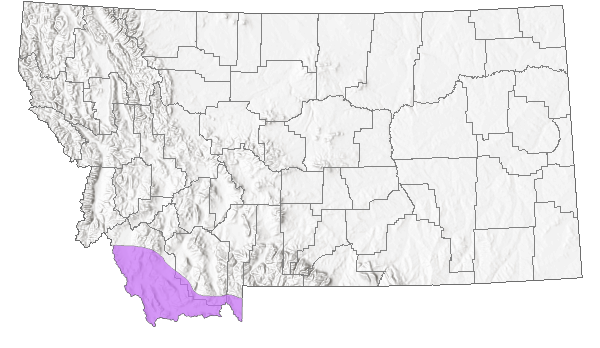
 Native
Native
Range Comments
East of the Cascades in OR east to MT and WY and south to CO, UT, NV, and CA.
Observations in Montana Natural Heritage Program Database
Number of Observations: 4
(Click on the following maps and charts to see full sized version)
Map Help and Descriptions
Relative Density
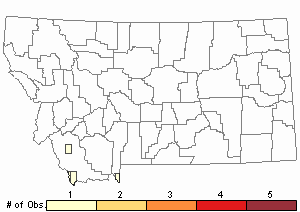
Recency
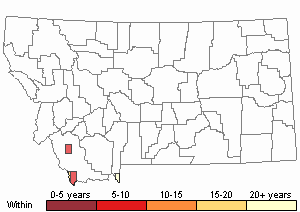
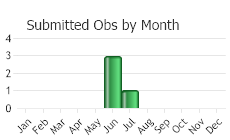
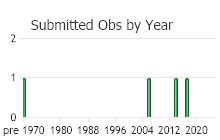
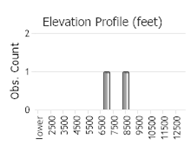 (Observations spanning multiple months or years are excluded from time charts)
(Observations spanning multiple months or years are excluded from time charts)
Habitat
Vernally moist grasslands and sagebrush steppe.
Ecological Systems Associated with this Species
Stewardship Responsibility
Threats or Limiting Factors
STATE THREAT SCORE REASON
Threat impact not assigned because threats are not known (MTNHP Threat Assessment 2021).
References
- Literature Cited AboveLegend:
 View Online Publication
View Online Publication Lesica, P., M.T. Lavin, and P.F. Stickney. 2012. Manual of Montana Vascular Plants. Fort Worth, TX: BRIT Press. viii + 771 p.
Lesica, P., M.T. Lavin, and P.F. Stickney. 2012. Manual of Montana Vascular Plants. Fort Worth, TX: BRIT Press. viii + 771 p. MTNHP Threat Assessment. 2021. State Threat Score Assignment and Assessment of Reported Threats from 2006 to 2021 for State-listed Vascular Plants. Botany Program, Montana Natural Heritage Program, Helena, Montana.
MTNHP Threat Assessment. 2021. State Threat Score Assignment and Assessment of Reported Threats from 2006 to 2021 for State-listed Vascular Plants. Botany Program, Montana Natural Heritage Program, Helena, Montana.
- Additional ReferencesLegend:
 View Online Publication
View Online Publication
Do you know of a citation we're missing? Heidel, B. L. 1996. Noteworthy collections - Montana. Madrono 43(3):436-440.
Heidel, B. L. 1996. Noteworthy collections - Montana. Madrono 43(3):436-440. Lesica, P., M.T. Lavin, and P.F. Stickney. 2022. Manual of Montana Vascular Plants, Second Edition. Fort Worth, TX: BRIT Press. viii + 779 p.
Lesica, P., M.T. Lavin, and P.F. Stickney. 2022. Manual of Montana Vascular Plants, Second Edition. Fort Worth, TX: BRIT Press. viii + 779 p. Wherry, E.T. 1944. Review of the genera Collomia and Gymnosteris. American Midland Naturalist 31:216-231.
Wherry, E.T. 1944. Review of the genera Collomia and Gymnosteris. American Midland Naturalist 31:216-231.
- Web Search Engines for Articles on "Small-flower Gymnosteris"





